
Sedimentology, Sedimentary Petrology, and Stratigraphy explore the interaction of sediments and sedimentary and volcaniclastic rocks with the biosphere, hydrosphere, atmosphere, cryosphere, and crust of the earth.
Sedimentology involves the description, classification, modeling, and interpretation of marine and nonmarine sediments so as to determine the physical, chemical, and biological processes by which they formed.
Sedimentary petrology studies the mineralogical and geochemical composition of sediments and sedimentary rocks to determine depositional and post-depositional processes of formation.
Stratigraphy uses physical, geophysical, paleontological, and geochemical techniques to describe the natural subdivisions of sedimentary and volcanic strata, their distribution, their chronological succession, and the structure and history of the crust.
The study of sediments and sedimentary rocks is societally relevant because they host most of the world's metallic, non-metallic, fuel, and agricultural resources, record the origin and evolution of life, and are the major substrate of environmental geology.
Scott Bennett
Roger Buick
Katharine Huntington
Alexis Licht
Chuck Nittrouer